Hybrid Machine Learning Models for Classifying Power Quality Disturbances: A Comparative Study
Abstract
1. Introduction
2. Initial Feature Set Extraction Based on S-Transform and Statistical Parameters
Disturbance Energy Ratio (DER) Index
3. Optimal Feature Selection: GA and CSO
3.1. Genetic Algorithm
- Initial (parent) population size: 10 (chromosomes).
- Crossover rate: 0.8.
- Mutation rate: 0.01.
3.2. Competitive Swarm Optimization
4. Classifiers: K-NN, SVMs, and DTs
4.1. K-Nearest Neighbors’ Algorithm
4.2. Support Vector Machine
4.3. Decision Tree
4.4. Bagged Decision Tree Ensemble
5. Full Comparative Classification of PQDs: Detailed Overview
6. Field Data Synthesis of PQDs
6.1. Generation of PQ Disturbances
- First, electrical input signals were defined and the user set their parameters.
- Second, signals according to these specifications were built.
- Finally, the synthesized signals could be sent either to a file or a data acquisition board (DAQ).
6.2. Training/Testing and Validation Datasets
6.3. PQDs’ Classes
7. Results and Performance Comparison
8. Conclusions
Author Contributions
Funding
Conflicts of Interest
Appendix A
References
- Stockwell, R.; Mansinha, L.; Lowe, R. Localization of the complex spectrum: The S transform. IEEE Trans. Signal Process. 1996, 44, 998–1001. [Google Scholar] [CrossRef]
- Borras, M.D.; Bravo, J.C.; Montano, J.C. Disturbance Ratio for Optimal Multi-Event Classification in Power Distribution Networks. IEEE Trans. Ind. Electron. 2016, 63, 3117–3124. [Google Scholar] [CrossRef]
- Bravo, J.C.; Borras, M.D.; Torres, F.J. Development of a smart wavelet-based power quality monitoring system. In Proceedings of the 2018 International Conference on Smart Energy Systems and Technologies (SEST), Seville, Spain, 10–12 September 2018; pp. 1–6. [Google Scholar]
- Borras, M.-D.; Montano, J.-C.; Castilla, M.; López, A.; Gutierrez, J.; Bravo, J.-C. Voltage index for stationary and transient states. In Proceedings of the Mediterranean Electrotechnical Conference (MELECON), Valletta, Malta, 26–28 April 2010; pp. 679–684. [Google Scholar]
- Sahani, M.; Dash, P. FPGA-Based Online Power Quality Disturbances Monitoring Using Reduced-Sample HHT and Class-Specific Weighted RVFLN. IEEE Trans. Ind. Inform. 2019, 15, 4614–4623. [Google Scholar] [CrossRef]
- Afroni, M.J.; Sutanto, D.; Stirling, D. Analysis of Nonstationary Power-Quality Waveforms Using Iterative Hilbert Huang Transform and SAX Algorithm. IEEE Trans. Power Deliv. 2013, 28, 2134–2144. [Google Scholar] [CrossRef]
- Xi, Y.; Li, Z.; Zeng, X.; Tang, X.; Liu, Q.; Xiao, H. Detection of power quality disturbances using an adaptive process noise covariance Kalman filter. Digit. Signal Process. 2018, 76, 34–49. [Google Scholar] [CrossRef]
- Nie, X. Detection of Grid Voltage Fundamental and Harmonic Components Using Kalman Filter Based on Dynamic Tracking Model. IEEE Trans. Ind. Electron. 2020, 67, 1191–1200. [Google Scholar] [CrossRef]
- He, S.; Zhang, M.; Tian, W.; Zhang, J.; Ding, F. A Parameterization Power Data Compress Using Strong Trace Filter and Dynamics. IEEE Trans. Instrum. Meas. 2015, 64. [Google Scholar] [CrossRef]
- Manikandan, M.S.; Samantaray, S.R.; Kamwa, I. Detection and Classification of Power Quality Disturbances Using Sparse Signal Decomposition on Hybrid Dictionaries. IEEE Trans. Instrum. Meas. 2014, 64, 27–38. [Google Scholar] [CrossRef]
- Cho, S.-H.; Jang, G.; Kwon, S.-H. Time-Frequency Analysis of Power-Quality Disturbances via the Gabor–Wigner Transform. IEEE Trans. Power Deliv. 2009, 25, 494–499. [Google Scholar] [CrossRef]
- Lopez-Ramirez, M.; Ledesma-Carrillo, L.M.; Cabal-Yepez, E.; Rodriguez-Donate, C.; Miranda-Vidales, H.; Garcia-Perez, A. EMD-Based Feature Extraction for Power Quality Disturbance Classification Using Moments. Energies 2016, 9, 565. [Google Scholar] [CrossRef]
- Camarena-Martinez, D.; Valtierra-Rodriguez, M.; Perez-Ramirez, C.A.; Amezquita-Sanchez, J.P.; Romero-Troncoso, R.D.J.; Garcia-Perez, A. Novel Downsampling Empirical Mode Decomposition Approach for Power Quality Analysis. IEEE Trans. Ind. Electron. 2015, 63, 2369–2378. [Google Scholar] [CrossRef]
- Wu, X.; Kumar, V.; Ross Quinlan, J.; Ghosh, J.; Yang, Q.; Motoda, H.; McLachlan, G.J.; Ng, A.; Liu, B.; Yu, P.S.; et al. Top 10 algorithms in data mining. Knowl. Inf. Syst. 2008, 14, 1–37. [Google Scholar] [CrossRef]
- Shen, Y.; Abubakar, M.; Liu, H.; Hussain, F. Power Quality Disturbance Monitoring and Classification Based on Improved PCA and Convolution Neural Network for Wind-Grid Distribution Systems. Energies 2019, 12, 1280. [Google Scholar] [CrossRef]
- Erişti, H.; Yıldırım, Ö.; Erişti, B.; Demir, Y. Optimal feature selection for classification of the power quality events using wavelet transform and least squares support vector machines. Int. J. Electr. Power Energy Syst. 2013, 49, 95–103. [Google Scholar] [CrossRef]
- Huang, N.; Peng, H.; Cai, G.; Chen, J. Power Quality Disturbances Feature Selection and Recognition Using Optimal Multi-Resolution Fast S-Transform and CART Algorithm. Energies 2016, 9, 927. [Google Scholar] [CrossRef]
- Moon, S.-K.; Kim, J.-O.; Kim, C. Multi-Labeled Recognition of Distribution System Conditions by a Waveform Feature Learning Model. Energies 2019, 12, 1115. [Google Scholar] [CrossRef]
- Huang, N.; Lu, G.; Cai, G.; Xu, D.; Xu, J.; Li, F.; Zhang, L. Feature Selection of Power Quality Disturbance Signals with an Entropy-Importance-Based Random Forest. Entropy 2016, 18, 44. [Google Scholar] [CrossRef]
- Jamali, S.; Farsa, A.R.; Ghaffarzadeh, N. Identification of optimal features for fast and accurate classification of power quality disturbances. Meas. J. Int. Meas. Confed. 2018, 116, 565–574. [Google Scholar] [CrossRef]
- Singh, U.; Singh, S.N. Optimal Feature Selection via NSGA-II for Power Quality Disturbances Classification. IEEE Trans. Ind. Inform. 2017, 14, 2994–3002. [Google Scholar] [CrossRef]
- Ray, P.K.; Mohanty, S.R.; Kishor, N.; Catalão, J.P. Optimal Feature and Decision Tree-Based Classification of Power Quality Disturbances in Distributed Generation Systems. IEEE Trans. Sustain. Energy 2013, 5, 200–208. [Google Scholar] [CrossRef]
- Dehini, R.; Sefiane, S. Power quality and cost improvement by passive power filters synthesis using ant colony algorithm. J. Theor. Appl. Inf. Technol. 2011, 23, 70–79. [Google Scholar]
- Singh, U.; Singh, S.N. A new optimal feature selection scheme for classification of power quality disturbances based on ant colony framework. Appl. Soft Comput. 2019, 74, 216–225. [Google Scholar] [CrossRef]
- Wang, J.; Xu, Z.; Che, Y. Power Quality Disturbance Classification Based on DWT and Multilayer Perceptron Extreme Learning Machine. Appl. Sci. 2019, 9, 2315. [Google Scholar] [CrossRef]
- Chen, Z.; Han, X.; Fan, C.; Zheng, T.; Mei, S. A Two-Stage Feature Selection Method for Power System Transient Stability Status Prediction. Energies 2019, 12, 689. [Google Scholar] [CrossRef]
- Huang, N.; Zhang, S.; Cai, G.; Xu, D. Power Quality Disturbances Recognition Based on a Multiresolution Generalized S-Transform and a PSO-Improved Decision Tree. Energies 2015, 8, 549–572. [Google Scholar] [CrossRef]
- Vidhya, S.; Kamaraj, V. Particle swarm optimized extreme learning machine for feature classification in power quality data mining. Automatika 2017, 58, 487–494. [Google Scholar] [CrossRef]
- Cheng, R.; Jin, Y. A competitive swarm optimizer for large scale optimization. IEEE Trans. Cybern. 2014, 45, 191–204. [Google Scholar] [CrossRef]
- Gu, S.; Cheng, R.; Jin, Y. Feature selection for high-dimensional classification using a competitive swarm optimizer. Soft Comput. 2018, 22, 811–822. [Google Scholar] [CrossRef]
- Niu, B.; Yang, X.; Wang, H. Feature Selection Using a Reinforcement-Behaved Brain Storm Optimization. In Intelligent Computing Methodologies; Huang, D.-S., Huang, Z.-K., Hussain, A., Eds.; Springer International Publishing: Cham, Switzerland, 2019; Volume 11645, pp. 672–681. [Google Scholar]
- Sharaf, A.M.; El-Gammal, A.A.A. A discrete particle swarm optimization technique (DPSO) for power filter design. In Proceedings of the 2009 4th International Design and Test Workshop (IDT), Riyadh, Saudi Arabia, 15–17 November 2009. [Google Scholar] [CrossRef]
- Zhao, L.; Long, Y. An Improved PSO Algorithm for the Classification of Multiple Power Quality Disturbances. J. Inf. Process. Syst. 2019, 15, 116–126. [Google Scholar] [CrossRef]
- De Yong, D.; Bhowmik, S.; Magnago, F. Optimized Complex Power Quality Classifier Using One vs. Rest Support Vector Machines. Energy Power Eng. 2017, 9, 568–587. [Google Scholar] [CrossRef][Green Version]
- Janik, P.; Lobos, T. Automated Classification of Power-Quality Disturbances Using SVM and RBF Networks. IEEE Trans. Power Deliv. 2006, 21, 1663–1669. [Google Scholar] [CrossRef]
- Hajian, M.; Foroud, A.A. A new hybrid pattern recognition scheme for automatic discrimination of power quality disturbances. Measurement 2014, 51, 265–280. [Google Scholar] [CrossRef]
- Thirumala, K.; Pal, S.; Jain, T.; Umarikar, A.C. A classification method for multiple power quality disturbances using EWT based adaptive filtering and multiclass SVM. Neurocomputing 2019, 334, 265–274. [Google Scholar] [CrossRef]
- Li, J.; Teng, Z.; Tang, Q.; Song, J. Detection and Classification of Power Quality Disturbances Using Double Resolution S-Transform and DAG-SVMs. IEEE Trans. Instrum. Meas. 2016, 65, 2302–2312. [Google Scholar] [CrossRef]
- Noh, F.H.M.; Rahman, M.A.; Yaakub, M.F. Performance of Modified S-Transform for Power Quality Disturbance Detection and Classification. Telkomnika 2017, 15, 1520–1529. [Google Scholar]
- Zhong, T.; Zhang, S.; Cai, G.; Huang, N. Power-Quality disturbance recognition based on time-Frequency analysis and decision tree. IET Gener. Transm. Distrib. 2018, 12, 4153–4162. [Google Scholar] [CrossRef]
- Alqam, S.J.; Zaro, F.R. Power Quality Detection and Classification Using S-Transform and Rule-Based Decision Tree. Int. J. Electr. Electron. Eng. Telecommun. 2019, 1–6. [Google Scholar] [CrossRef]
- Biswal, M.; Dash, P.K. Measurement and Classification of Simultaneous Power Signal Patterns With an S-Transform Variant and Fuzzy Decision Tree. IEEE Trans. Ind. Inform. 2012, 9, 1819–1827. [Google Scholar] [CrossRef]
- Mahela, O.P.; Shaik, A.G. Recognition of power quality disturbances using S-transform based ruled decision tree and fuzzy C-means clustering classifiers. Appl. Soft Comput. 2017, 59, 243–257. [Google Scholar] [CrossRef]
- Samantaray, S. Decision tree-Initialised fuzzy rule-Based approach for power quality events classification. IET Gener. Transm. Distrib. 2010, 4, 538. [Google Scholar] [CrossRef]
- Goldberg, D.E.; Holland, J.H. Genetic Algorithms and Machine Learning. Mach. Learn. 1988, 3, 95–99. [Google Scholar] [CrossRef]
- Siedlecki, W.; Sklansky, J. A note on genetic algorithms for large-scale feature selection. Pattern Recognit. Lett. 1989, 10, 335–347. [Google Scholar] [CrossRef]
- Kang, M.; Kim, J.; Wills, L.; Kim, J.-M. Time-Varying and Multiresolution Envelope Analysis and Discriminative Feature Analysis for Bearing Fault Diagnosis. IEEE Trans. Ind. Electron. 2015, 62, 7749–7761. [Google Scholar] [CrossRef]
- Fan, G.-F.; Guo, Y.-H.; Zheng, J.-M.; Hong, W.-C. Application of the Weighted K-Nearest Neighbor Algorithm for Short-Term Load Forecasting. Energies 2019, 12, 916. [Google Scholar] [CrossRef]
- Vapnik, V.N. The Nature of Statistical Learning Theory; Springer: Berlin/Heidelberg, Germany, 1995. [Google Scholar]
- Cortes, C.; Vapnik, V. Support-Vector networks. Mach. Learn. 1995, 20, 273–297. [Google Scholar] [CrossRef]
- Ozgonenel, O.; Yalcin, T.; Guney, I.; Kurt, Ü. A new classification for power quality events in distribution systems. Electr. Power Syst. Res. 2013, 95, 192–199. [Google Scholar] [CrossRef]
- De Yong, D.; Bhowmik, S.; Magnago, F. An effective Power Quality classifier using Wavelet Transform and Support Vector Machines. Expert Syst. Appl. 2015, 42, 6075–6081. [Google Scholar] [CrossRef]
- A Survey on Decision Tree Algorithms of Classification in Data Mining. Int. J. Sci. Res. 2016, 5, 2094–2097. [CrossRef]
- Breiman, L. Random Forests. Mach. Learn. 2001, 45, 5–32. [Google Scholar] [CrossRef]
- IEEE Power and Energy Society. IEEE Standard Definitions for the Measurement of Electric Power Quantities Under Sinusoidal, Nonsinusoidal, Balanced, or Unbalanced Conditions; IEEE Std 1459-2010 (Revision IEEE Std 1459-2000); IEEE: New York City, NY, USA, 2010; pp. 1–50. [Google Scholar]
- European Committee for Electrotechnical Standardization. Voltage Characteristics of Electricity Supplied by Public Distribution Networks; EN-50160 2011; Eur. Std: 2010; CENELEC: Brussels, Belgium, 2010. [Google Scholar]
- IEEE Power and Energy Society. IEEE Recommended Practice for Monitoring Electric Power Quality; IEEE Std 1159-2019 (Revision IEEE Std 1159-2009); IEEE: New York City, NY, USA, 2019; pp. 1–98. [Google Scholar]
- Kumar, R.; Singh, B.; Shahani, D.T.; Chandra, A.; Al-Haddad, K.; Garg, R. Recognition of Power-Quality Disturbances Using S-Transform-Based ANN Classifier and Rule-Based Decision Tree. IEEE Trans. Ind. Appl. 2014, 51, 1249–1258. [Google Scholar] [CrossRef]
- Wang, H.; Wang, P.; Liu, T. Power Quality Disturbance Classification Using the S-Transform and Probabilistic Neural Network. Energies 2017, 10, 107. [Google Scholar] [CrossRef]
- Khokhar, S.; Zin, A.A.M.; Memon, A.P.; Mokhtar, A.S. A new optimal feature selection algorithm for classification of power quality disturbances using discrete wavelet transform and probabilistic neural network. Measurement 2017, 95, 246–259. [Google Scholar] [CrossRef]
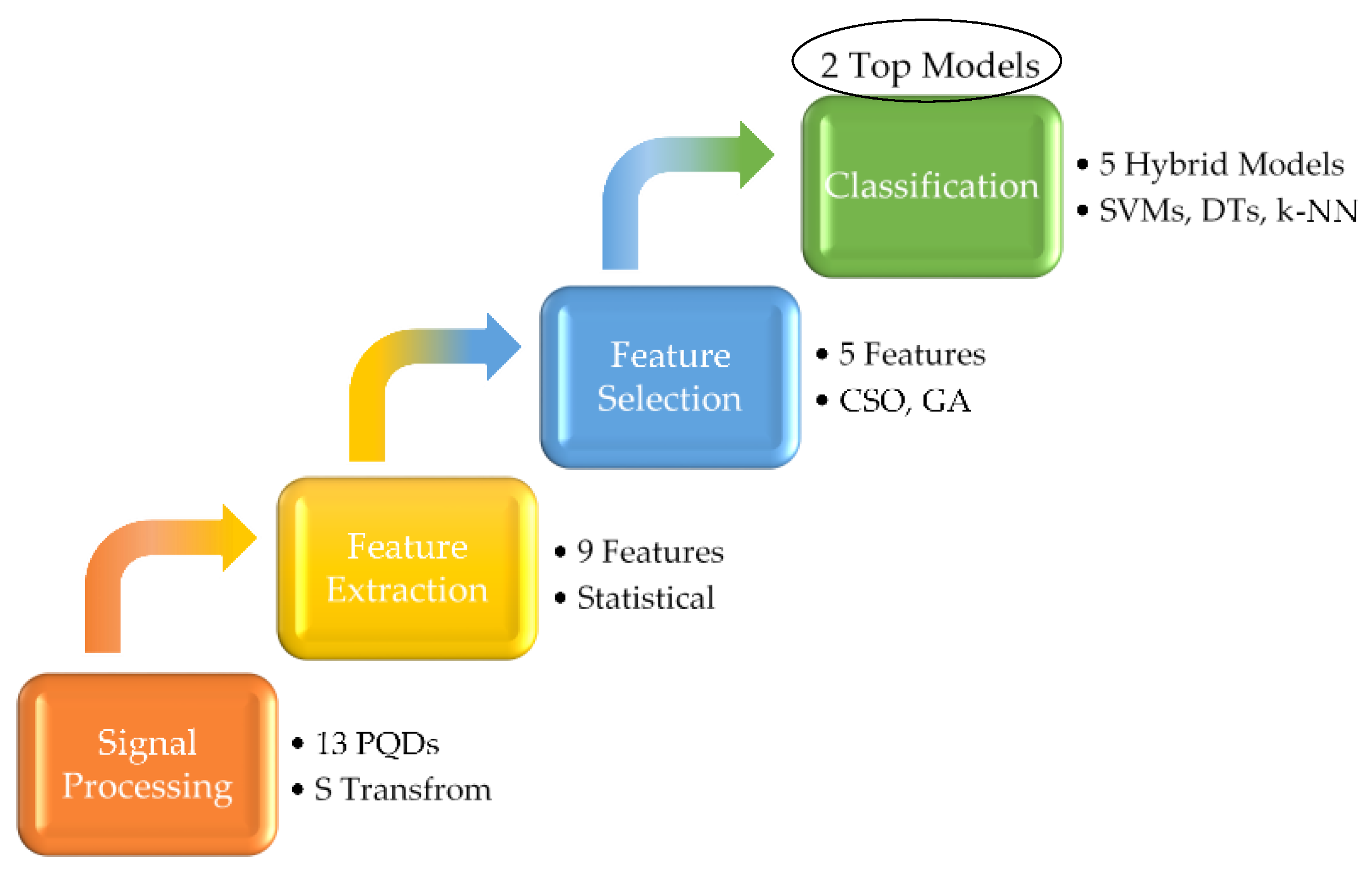
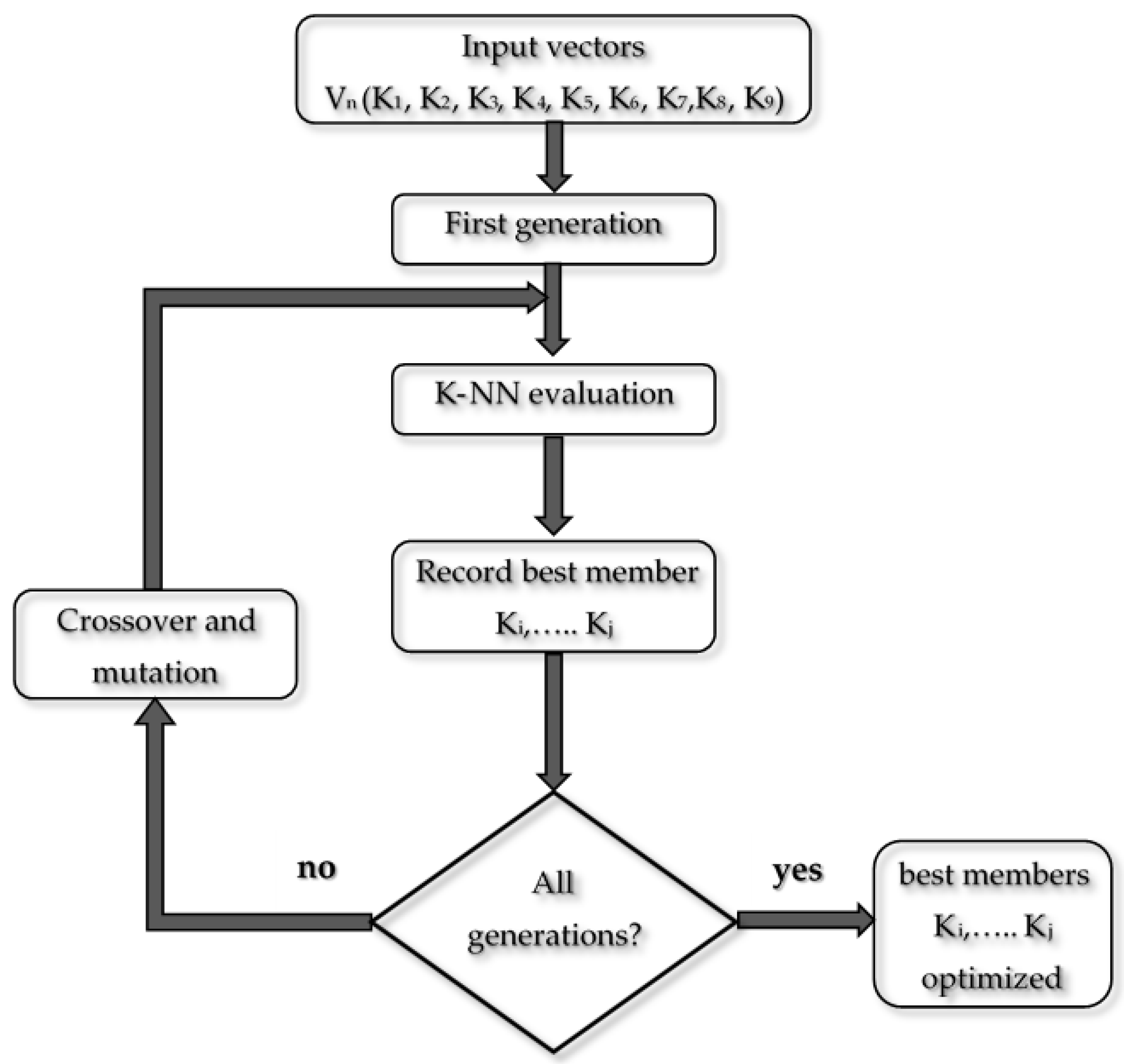

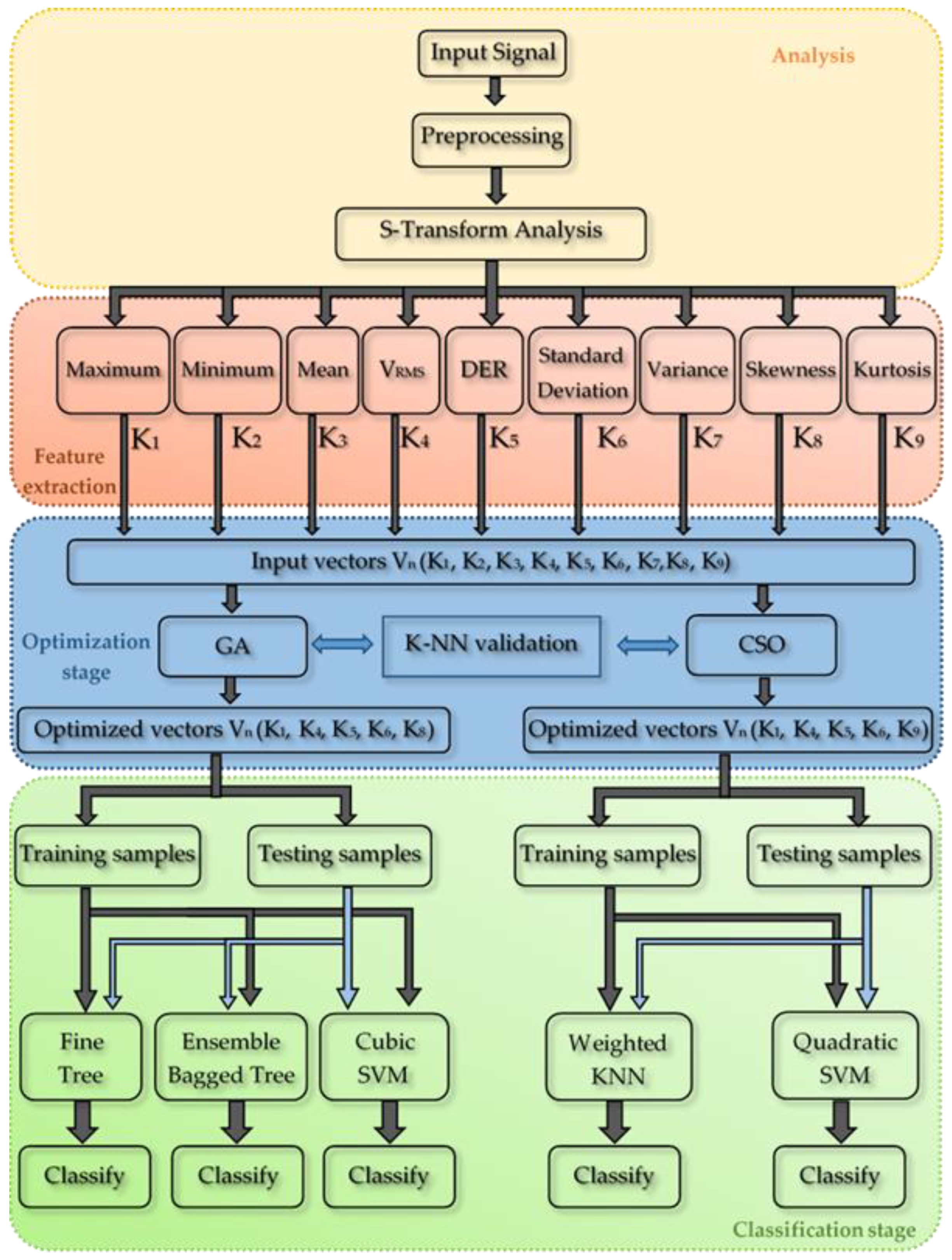
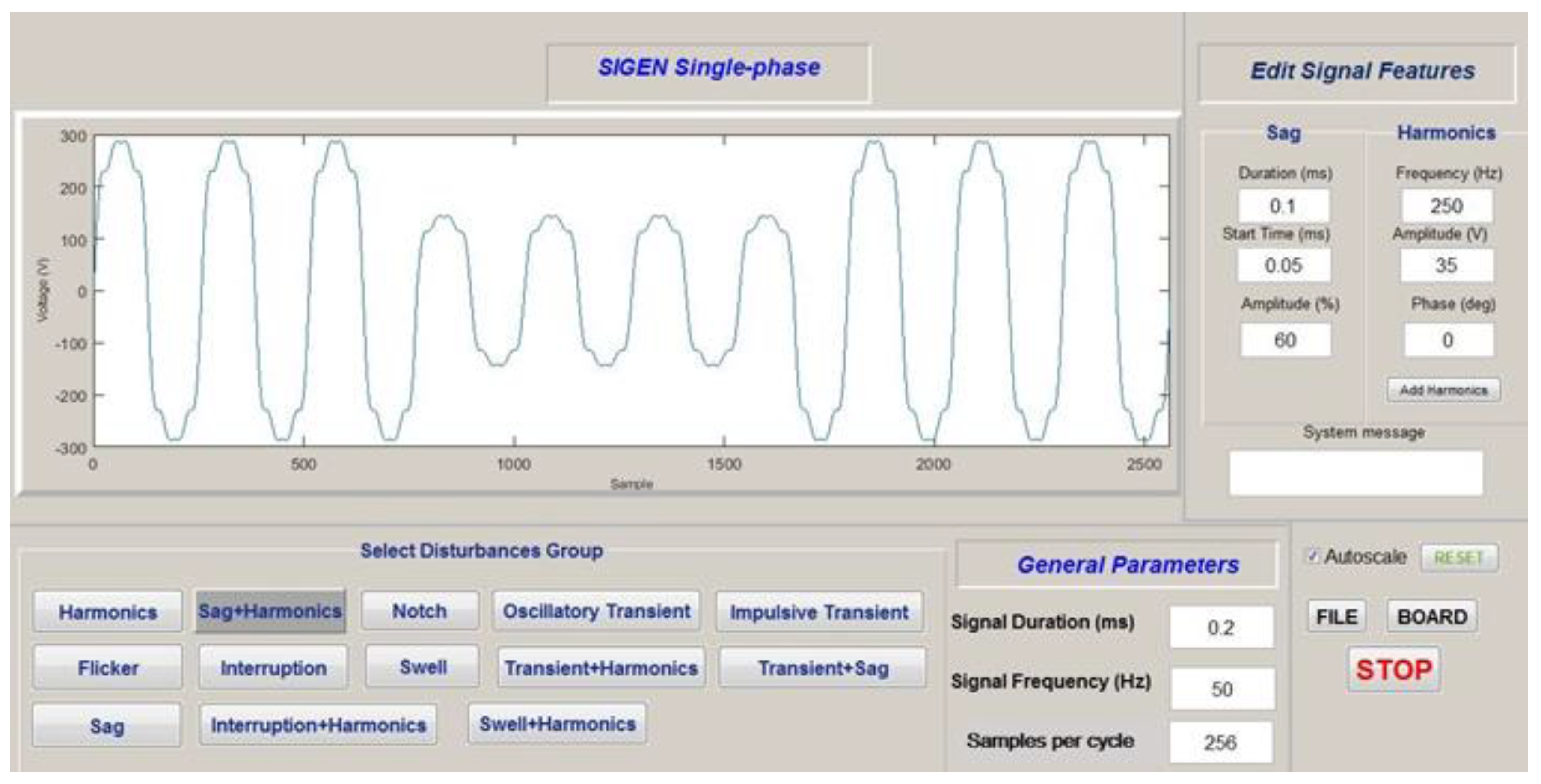
| Extracted Features | |||||
|---|---|---|---|---|---|
| K1 | Maximum | 1 | Standard deviation | K6 | |
| K2 | Minimum | Variance | K7 | ||
| K3 | Mean value | Skewness (phase) 2 | K8 | ||
| K4 | RMS | Kurtosis | K9 | ||
| K5 | DER | - | - | ||
| (C1) | 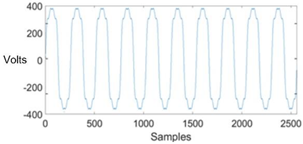 |  | (C2) |
| (C3) | 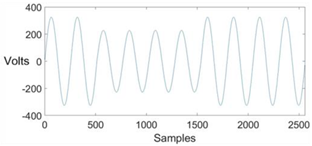 | 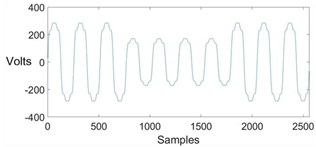 | (C4) |
| (C5) | 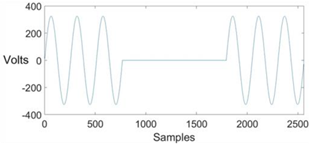 | 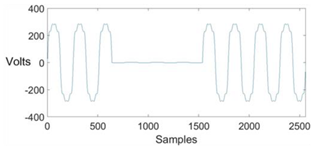 | (C6) |
| (C7) | 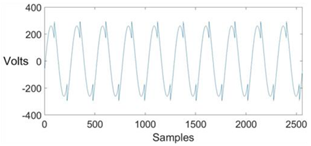 | 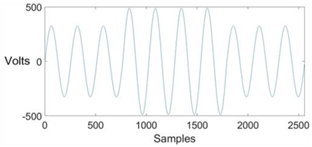 | (C8) |
| (C9) | 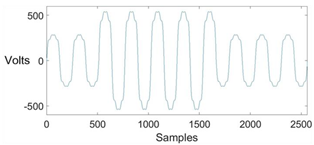 | 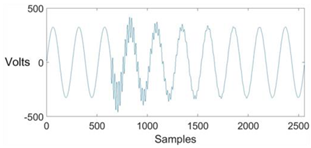 | (C10) |
| (C11) | 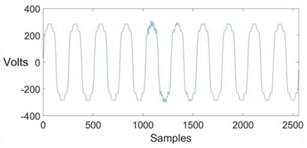 |  | (C12) |
| (C13) | 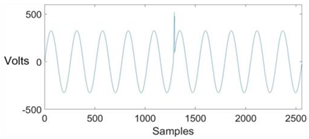 | 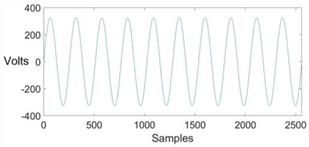 | Pure Sine |
| Accuracy Comparison between Proposed Models (%) | ||||
|---|---|---|---|---|
| Optimization & Classification | SNR | |||
| 20 dB | 30 dB | 40 dB | 50 dB | |
| CSO&QSVM | 97.6 | 99.2 | 99.85 | 99.95 |
| CSO&WK-NN | 95.7 | 98.6 | 99.7 | 99.75 |
| GA&FTree | 93.4 | 97.7 | 99.3 | 99.5 |
| GA&ETree | 94.6 | 97.5 | 99.4 | 99.55 |
| GA&CSVM | 94.4 | 97.7 | 99.0 | 99.4 |
| Minimum SNR (dB) for Individual PQD Classification Using the Models Proposed and According to 3 Levels of Accuracy | ||||||||||||||||
|---|---|---|---|---|---|---|---|---|---|---|---|---|---|---|---|---|
| CSO Optimizer | Genetic Algorithm | |||||||||||||||
| Quadratic SVM | Weighted K-NN | Fine Tree | Ensemble Tree | Cubic SVM | ||||||||||||
| PQDs | Accuracy | 100% | 90% | 80% | 100% | 90% | 80% | 100% | 90% | 80% | 100% | 90% | 80% | 100% | 90% | 80% |
| Harmonic | 26.7 | 26 | 25.3 | 26.65 | 25.4 | 25 | 25.9 | 25.1 | 24.8 | 25.5 | 25.2 | 24.9 | X | X | X | |
| Flicker | 23 | 19.3 | 17.6 | 24.7 | 24.3 | 23.9 | 14.4 | 13.2 | 12.9 | 13.5 | 13.1 | 12.8 | 19.4 | 18.5 | 18.1 | |
| Sag | 18.8 | 18.1 | 17.2 | 22.7 | 21.7 | 21.35 | 15.4 | 14.6 | 14.3 | 12.6 | 12.35 | 12.1 | 12.7 | 12.3 | 12.1 | |
| Sag + H | 19 | 18 | 16.3 | 16.8 | 15.8 | 15.3 | 15.2 | 14 | 13.6 | 19 | 16.5 | 15.6 | 19 | 17.2 | 15.8 | |
| Interruption | 14 | 13.2 | 12.7 | 17.5 | 16.3 | 15.9 | 11.5 | 11.15 | 10.9 | 11.5 | 11.1 | 10.85 | 18 | 16.2 | 14.5 | |
| Interruption + H | 10 | 9.3 | 8.8 | 11.3 | 10.8 | 10.5 | X | X | X | X | X | X | X | X | X | |
| Notch | 13 | 11.4 | 10.9 | 16.5 | 15.8 | 14 | 12.4 | 11.85 | 11.6 | 12.4 | 10.95 | 10.65 | X | X | X | |
| Swell | 15.9 | 15.3 | 14.9 | 15.4 | 14.95 | 14.65 | 16.25 | 15.9 | 15.65 | 10.95 | 9.9 | 9.2 | 15.4 | 14.85 | 14.6 | |
| Swell + H | 13.5 | 12.85 | 12.6 | 14.5 | 14.25 | 14 | X | X | X | X | X | X | 12.5 | 11.6 | 11 | |
| Osc. Transient | 21 | 19.7 | 19.35 | 24.4 | 22.6 | 21.7 | 15 | 13.5 | 12.4 | 13.8 | 12.7 | 10.5 | 12.55 | 11.7 | 11.1 | |
| Osc. Transient + H | 22.8 | 20.2 | 19.6 | 25.3 | 23.7 | 22.45 | 16.75 | 16 | 13.8 | 13.1 | 10.6 | 9.5 | 17 | 15.8 | 13.1 | |
| Osc. Transient + Sag | 21.7 | 19.4 | 18.9 | 19.85 | 19.3 | 19.1 | 14.6 | 13.9 | 13 | 11.45 | 9.9 | 9 | 16.8 | 15.6 | 13.6 | |
| Impulsive Transient | 22 | 20.4 | 19.8 | 19 | 18.35 | 18.2 | 18.4 | 17.2 | 15 | 21.2 | 18 | 16.6 | 15.3 | 14.5 | 13.6 | |
| Overall SNR (dB) | 18.57 | 17.16 | 16.46 | 19.54 | 18.71 | 18.16 | 15.95 | 15.13 | 14.36 | 15.02 | 13.66 | 12.85 | 15.87 | 14.82 | 13.75 | |
| Literature | Processing & Recognition | Nº of PQDs | Nº of Features | Recognition Accuracy (%) | |||
|---|---|---|---|---|---|---|---|
| 20 dB | 30 dB | 40 dB | 50 dB | ||||
| [15] | PCA + CNN | 12 | 6 | 99.76 | - | - | 99.85 |
| [17] | Fast ST + Embedded DT | 12 | 6 | 91.50 | 98.58 | 98.83 | 98.92 |
| [27] | Mod. ST + DT + PSO | 13 | 6 | - | - | 98.38 | - |
| [37] | Wavelet + SVM | 16 | 6 | - | - | - | 95.56 |
| [38] | ST+DAG-SVM | 9 | 9 | 97.77 | - | - | - |
| [39] | Modified ST + SVM | 8 | 19 | 98 | - | - | - |
| [41] | ST + DT | 7 | 6 | 98.1 | - | - | - |
| [42] | FST + Fuzzy DT | 13 | 5 | - | 97.95 | 98.67 | - |
| [43] | ST + DT+ Fuzzy C-M | 10 | 14 | 99.3 | - | - | - |
| [58] | ST + ANN + DT | 13 | - | - | - | - | 99.9 |
| [59] | ST + PNN | 9 | 4 | 98.38 | 98.63 | 99.13 | - |
| [60] | Wavelet +PNN | 14 | 5 | 86.86 | 91.93 | 93.71 | 94.57 |
| Proposed | ST + CSO + SVM | 13 | 5 | 97.6 | 99.2 | 99.85 | 99.95 |
© 2020 by the authors. Licensee MDPI, Basel, Switzerland. This article is an open access article distributed under the terms and conditions of the Creative Commons Attribution (CC BY) license (http://creativecommons.org/licenses/by/4.0/).
Share and Cite
Bravo-Rodríguez, J.C.; Torres, F.J.; Borrás, M.D. Hybrid Machine Learning Models for Classifying Power Quality Disturbances: A Comparative Study. Energies 2020, 13, 2761. https://doi.org/10.3390/en13112761
Bravo-Rodríguez JC, Torres FJ, Borrás MD. Hybrid Machine Learning Models for Classifying Power Quality Disturbances: A Comparative Study. Energies. 2020; 13(11):2761. https://doi.org/10.3390/en13112761
Chicago/Turabian StyleBravo-Rodríguez, Juan Carlos, Francisco J. Torres, and María D. Borrás. 2020. "Hybrid Machine Learning Models for Classifying Power Quality Disturbances: A Comparative Study" Energies 13, no. 11: 2761. https://doi.org/10.3390/en13112761
APA StyleBravo-Rodríguez, J. C., Torres, F. J., & Borrás, M. D. (2020). Hybrid Machine Learning Models for Classifying Power Quality Disturbances: A Comparative Study. Energies, 13(11), 2761. https://doi.org/10.3390/en13112761






